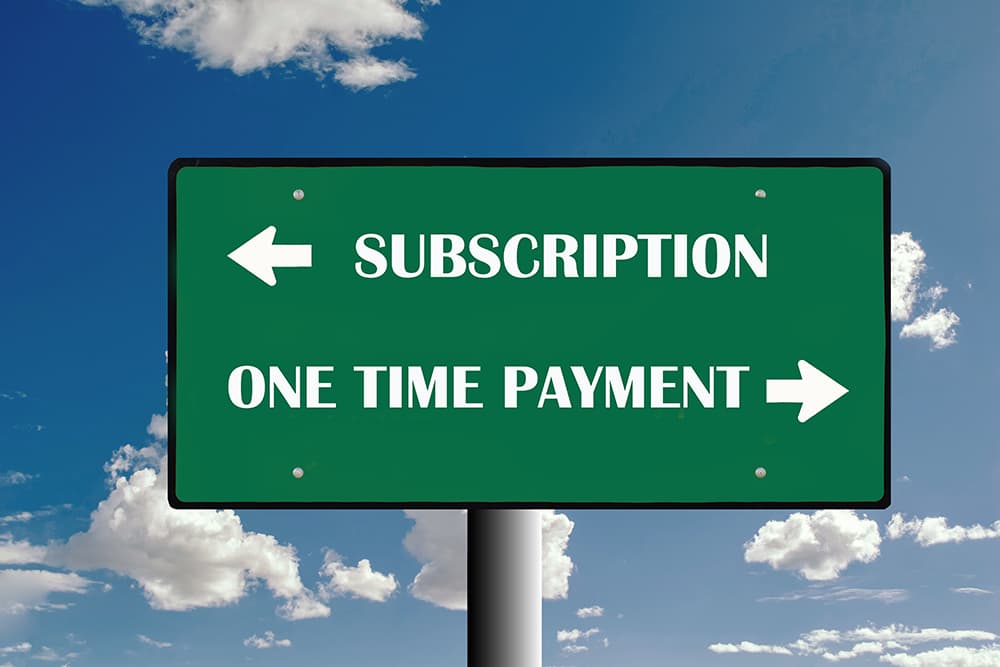Looking to offer subscription billing as a payment option? Here are four things you need to know.

Although they were once limited to only a few types of retail businesses, subscription-based payments are now taking the entire retail world by storm. That’s because card on file payments provide numerous benefits to both buyers and sellers alike.
If you are interested in jumping on this bandwagon, do your homework first so that you understand exactly what to expect.
What are recurring payments?
Traditionally, a consumer would purchase a product or service with a single payment. The exception to that rule happened when buyers used their credit cards and were thus able to stretch the payments over time — with interest added, of course.
Recently, the subscription or recurring payments arrangement has burst onto the scene, providing an exciting alternative.
Initiating these payments is simple. After first clearing it with your payment services provider, you set up an arrangement with the customer that presets the amount of money to be withdrawn from their bank account or credit card, as well as the date, the frequency, and the duration.
This results in predictable cash flow for the seller and no late payments or service interruptions for the customer. But what else should you know about recurring payments before you decide to incorporate them into your ecommerce or physical store?
1. You need to have the right products.
It’s a no-brainer that subscriptions work well if you are marketing software or fitness club memberships. However, the recent diversification of the recurring payments model is proof that it also works for businesses pitching everything from cat food to beauty products.
Even so, you need to determine for yourself if it will work for the products or services you want to offer.
This requires gaining an understanding of your customers and what you want to sell. If, for example, your bread and butter comes from items that are generally only purchased once, an ongoing subscription might not be the best plan, particularly for small-ticket merchandise.
Having said that, you could still set up your point of sale system to allow customers to cushion the blow of higher-priced items by allowing them to contribute set monetary amounts each month.
2. You probably can’t get started with recurring billing on your own.
Even if you are tech-savvy and have time on your hands, incorporating recurring billing into your business model is not a task you will want to take on without help. Fortunately, most payment service providers have come to understand that it is in their best interests to make the initialization process as painless and seamless as possible.
However, that is not necessarily the case for everyone. If your provider doesn’t offer recurring billing, or you’re not getting adequate support, there may be a plug-in or third-party provider that can help you get set up for a low monthly fee while assisting you down the line with issues like updating expired or closed cards and accounts.
3. Your recurring billing or subscription model should enhance the customer’s shopping experience.
From the minute someone clicks on your home page or walks in your door, your job is to provide a shopping experience that transcends mere buying and selling.
This maxim applies to the products and services you market, the staff you hire, and the work you do behind the scenes to make your retail operation run smoothly. Of course, the payment experience is no exception.
Allowing customers to use recurring payments or receive your products via subscriptions can be structured to ensure that it goes far beyond the exchange of money. When done right, subscription billing can:
- Apply to products or services that customers need and want.
- Make larger purchase amounts attainable by breaking them into smaller components over time.
- Provide convenience and relief from the stress of late payments.
- Enable you and your customer to have a positive and mutually beneficial relationship.
When done right, offering card on file payments can be one of the most productive customer service vehicles you can launch.
4. You need to take dunning into consideration.
You may never have heard of it, but any merchant who signs onto recurring billing will inevitably become acquainted with the concept of dunning. In terms of this payment model, dunning refers to those times when you will need to ask your customers for money they owe you.
Wait a minute, you might be saying. Aren’t seamless payments one of the main advantages of the subscription model? While the short answer is yes, the longer one is that it gets much more complicated.
That’s because numerous things can go wrong during the automatic payments process.
- The customer might close their bank account.
- They could change their credit card payment details.
- They could exceed their credit card spending limit, thus voiding the payment.
Like it or not, recurring billing is not set-and-forget. You will need to put processes in place that anticipate expiration dates, send reminder emails, communicate with customers, suspend accounts, retry declined payments and investigate their causes, and much more.
Many merchants opt to delegate this task to their payment provider or a third-party vendor since it can occupy a good deal of time.
Giving your customers the ability to pay for products with recurring billing will help to elevate your business above many of your competitors who do not provide a similar option. With the assistance of a high-quality payment services provider or a third-party vendor, you should have relatively little difficulty integrating this important service.
Once you do, it can provide a steadier and more predictable flow of cash that can pave the way for higher profits and greater expansion.






















